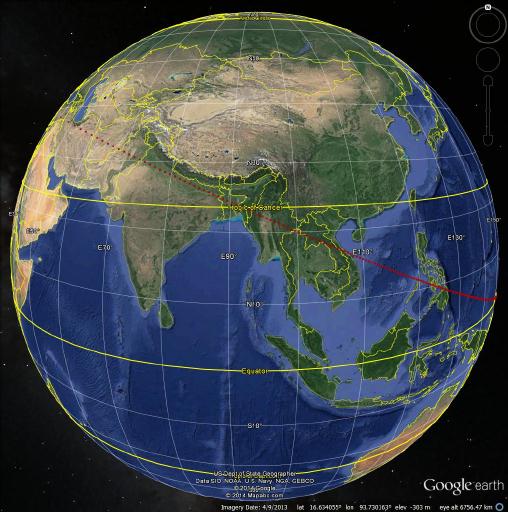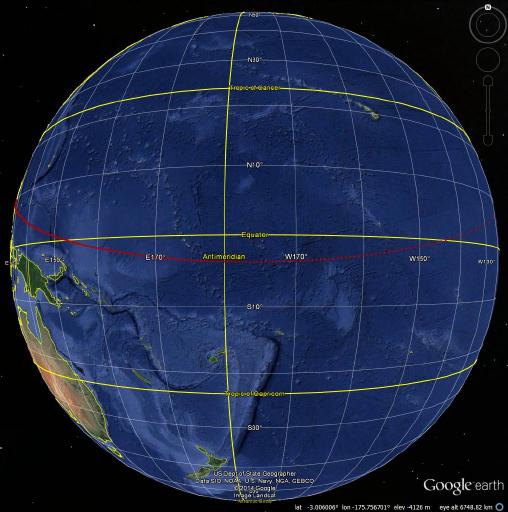



At the 2015 IAA Planetary Defense Conference (PDC), to be held April 13 - 17, 2015 in Frascati, Italy, a hypothetical asteroid impact scenario will be presented and used as a basis for discussion. NOTE: Although this scenario is realistic in many ways, it is completely fictional and does NOT describe a real potential asteroid impact. The scenario begins as follows:
The asteroid is discovered on April 13, 2015, the first day of the conference, at magnitude 20.9, declination -39 degrees and heading south. It is assigned the designation “2015 PDC” by the Minor Planet Center, and classified as a Potentially Hazardous Asteroid (PHA) based on its orbit. (To reinforce the fact that this is not a real asteroid, we are using three letters in the designation, something which would never be done for an actual asteroid.)
The asteroid’s orbital elements are known fairly accurately even in the first few days. Its mean distance from the Sun (semi-major axis) is 1.77 au, and the orbital eccentricity is 0.49. Its perihelion distance is 0.90 au and aphelion distance is 2.65 au; the orbital period is 864 days (2.37 years). The orbital inclination is fairly small: 5.35 deg. The asteroid’s orbit comes very close to the Earth’s orbit on its outbound leg, much like the Chelyabinsk impactor, but unlike Chelyabinsk, this asteroid impacts at its ascending node.
Very little is known about the object’s physical properties. Its absolute magnitude is estimated to be about H = 21.3 +/- 0.4, which puts the asteroid’s size at roughly 100 to 500 meters. The large size uncertainty is due to uncertainties in both albedo and H value.
At discovery, the asteroid is quite distant from the Earth, about 0.34 au (51 million kilometers or 32 million miles). It is approaching our planet and slowly brightening, but it peaks at only magnitude 20.3 on May 4. It reaches a closest aproach of about 0.19 au (28 million km or 18 million miles) from Earth on May 12. It never gets within range of the Goldstone radar and it’s too far south at close approach for the Arecibo radar.
The JPL Sentry system and University of Pisa’s CLOMON system both identify many potential impacts for this object at several future dates. The most likely potential impact date is 2022 Sep 3, but the impact probability for that date is still low in the first week after the asteroid is discovered. Nevertheless, as the object is tracked over the next few weeks, the impact probability for 2022 starts to climb, reaching 0.2% a month after discovery. Even as the asteroid fades past magnitude 22 in early June, it continues to be observed and tracked since the chance of impact just keeps rising.
The first part of the scenario ends in mid-June 2015, when the probability of Earth impact in 2022 has reached 1% and continues to rise. The rest of the scenario will be played out at the conference.
It is clear that the object will be observable through the rest of 2015, although it will be quite faint (22nd and 23rd magnitude) and observers will require fairly large (2-meter-class) telescopes to track it. In December 2015 and January 2016, the asteroid will fade through 24th and 25th magnitudes, requiring very large aperture telescopes such as the 4- and 8-meter class facilities of CFHT, Keck, Gemini, Subaru, VLT, etc. In the spring of 2016, the asteroid will move too close to the Sun to observed, and it will remain unobservable for about 7 months.
A special version of the JPL orbit viewer applet has been created for this object and can be accessed here.
The orbit of this hypothetical asteroid has been loaded into JPL’s HORIZONS system, and can be accessed via the name “2015 PDC”. HORIZONS can be accessed with this object preloaded via this web-interface.
For those familiar with the SPICE Toolkit software, an SPK file for the PDC exercise case may be retrieved here for programmatic use:
ftp://ssd.jpl.nasa.gov/pub/xfr/2015-PDC/2015_PDC-merged.DE430.bsp
The SPK file is consistent with and contains additional DE430 planetary ephemeris information over the time-span 1992-Jan-01 though 2022-Sep-03, permitting retrieval of object state vectors at any aribitrary instant within that timespan.
The asteroid’s uncertainty region at the time of the potential impact is much longer than the diameter of the Earth, but its width is much less. The intersection of the uncertainty region with the Earth creates the so-called “risk corridor” across the surface of the Earth. The corridor wraps more than halfway around the globe, as depicted by the red dots on these two Google Earth images.

|

|
| The corridor wraps more than halfway around the globe, as depicted by the red dots on these two Google Earth images. | |
A table of the impact circumstances of the points along this corridor can be found here. The columns of this table are as follows:
Note that the asteroid trajectory is too uncertain to say which of these impact points is the most likely. When the impact probability is low, these impact points are essentially equally likely, although the points become more widely spaced towards the ends of the corridor because the asteroid enters at shallower and shallower elevation angles.
In a collaboration with The Aerospace Corp., the NEO Program Office has developed an NEO Deflection App which is now available for use. The 2015 PDC trajectory is loaded into the App along with trajectories of several other simulated Earth impactors. The App allows users to apply various amounts of impulsive velocity changes at various times before impact and see the resulting deflection in the impact b-plane. The App can be configured to simulate kinetic impactor trajectories launched by several different launch vehicles; the outputs include the xi and zeta Opik b-plane coordinates of the deflected trajectory. Users are able to design their own deflection missions for the 2015 PDC trajectory and roughly determine the impact point of the deflected trajectory by interpolating in the table of impact circumstances given above.